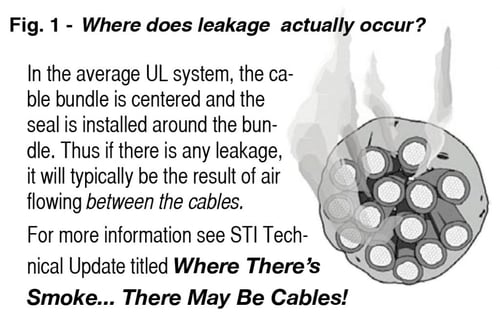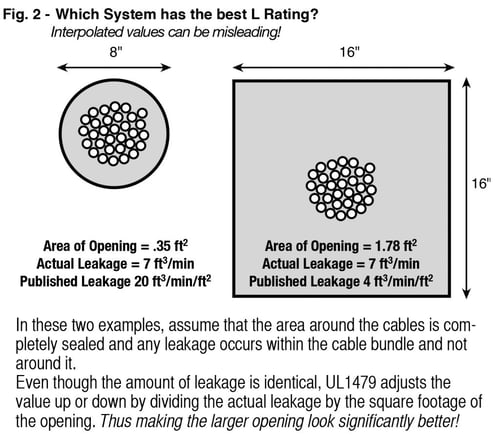The Problem With Leakage Ratings
More and more UL Firestop Sysems for cable penetrations now carry L-Ratings. Do you know what they mean? It seems simple doesn’t it? Air is pumped into a chamber and the rate at which it leaks out is measured. Pretty simple… Or is it? It would be if that’s all there was to it. Unfortunately there’s more to it than this. Unless you understand what you are reading, you may be mislead. The purpose of this Technical Update is to tell you how this published value is determined and just what it means.
While some of you may have actually witnessed a fire test at UL or elsewhere, I would be very surprised if any potential readers have witnessed the UL leakage testing. To get you prepared for this discussion, I’ll give you the benefit of our experience.
The requirements for leakage testing are found in UL/ANSI 1479. Since this requirement is not as yet included in ASTM E814, we will focus on the the requirements of the UL standard.
Leakage occurs within the cable bundle and not around it. Consider the typical cable installation depicted in a UL Through-Penetration System. The cable bundle is centered and the seal (be it putty, sealant, or foam muffins) is installed around it. These materials are not typically porous. This means that if there is leakage occurring, the air is flowing between the cables
rather than around them.
Some UL Systems with cables do have very low values that are legitimate. Firestop products or designs that seal around each individual cable will produce low leakage ratings. In areas where a hermetic seal is required, for example marine applications where penetrations occur in bulkheads, complex rubber block systems are installed and compressed tightly around each pipe and cable. This level of sealing may also be required for certain clean areas or pressurized areas within electronics manufacturing plants for example.
Other UL Systems indicate low values that are not! For most forms of normal construction however, it isn’t practical to attempt to seal cables air-tight. Achieving low values with cable bundles using sealants, putties, foam plugs, etc. require cables to be individually spaced and sealed so that air will not flow between them.
Published L Ratings – Be Sure to Read the Small Print! Don’t be fooled by low numbers. Extremely low numbers for cables usually mean that each cable has been individually sealed. Is this practical? Some pathway devices with self-contained firestopping require putty to be packed in both ends in order to achieve the rating. Be sure to read the small print.
These systems may also have cable bundles that are tightly cinched the cables are squeezed together with as little room between them as possible.
Since this is not practical in actual practice, these ratings simply are not realistic and the published values are not truly representative of what the average installer can reproduce in the field.
The bigger problem is how the actual test results are interpolated under UL1479. Looking at a UL System, you would naturally expect that if you install a single penetration using the parameters shown, you will get X leakage. You would also assume that if you install three of these penetrations, you will get 3X leakage. Unfortunately unless the actual tested opening size is exactly one square foot, you will not actually know the true leakage.
 UL1479 adjusts the actual value achieved in the test up or down by dividing the Actual Leakage by the square footage of the opening (See Fig. 2). This can produce some very surprising results. If the opening is smaller than one square foot, the leakage value will be increased. If the opening is larger than one square foot, it will decrease. It doesn’t make much sense, but if you install either one of the penetrations shown in Fig. 2, your actual leakage will be the same. However, the larger opening may meet code requirements and the smaller one will not.
UL1479 adjusts the actual value achieved in the test up or down by dividing the Actual Leakage by the square footage of the opening (See Fig. 2). This can produce some very surprising results. If the opening is smaller than one square foot, the leakage value will be increased. If the opening is larger than one square foot, it will decrease. It doesn’t make much sense, but if you install either one of the penetrations shown in Fig. 2, your actual leakage will be the same. However, the larger opening may meet code requirements and the smaller one will not.
What does “less than 1” really mean? UL1479 does not provide for a rating of zero (0). The lowest rating is “Less than 1”. Since this is the lowest possible rating, this would seem to be as good as it gets. However, consider an opening 5’ X 5’ (25 ft2) with no cables or penetrants of any kind. In theory, we could seal this opening with an impermeable membrane such as a metal-backed composite firestop sheet and caulk the edges so that there would be absolutely no leakage. However, using UL1479, the lowest rating that could be assigned would be “less than 1” rather than “0”.
Now let’s assume that we have created an opening in this firestop membrane and installed and firestopped a cable bundle. We re-test and subsequently measure leakage of 24 ft3 per minute, our interpolated leakage would be 24 ÷ 25 = .96 or “less than 1” once again. So even though we have no leakage in our first example and 24 ft3 in the second, anyone reading the two systems would never know the difference.
This standard and the codes need to be changed. Until then, be careful about the products and systems that you select. Don’t be afraid to call the manufacturer and request the Actual Leakage values. This is the only accurate measure of leakage.






